Engine Production: A Practical Overview
If you’ve ever wondered what goes into making the engines that power factories, cars, or HVAC systems, you’re in the right spot. Engine production isn’t magic – it’s a series of clear steps that turn raw metal into a reliable power source. In this guide we’ll break down each stage, share tips for keeping quality high, and show why sustainable practices matter, especially for a company like Blue D Air Control that focuses on air‑control engines.
Core Steps in Engine Production
First up is design. Engineers start with a digital model that defines size, power output, and the type of fuel or electricity the engine will use. Modern CAD software lets them test stress points and airflow without cutting any metal.
Next comes material selection. High‑strength steel, aluminum alloys, and sometimes advanced composites are chosen based on the engine’s size and the environment it will run in. For air‑control engines, heat‑resistant alloys are a must because they run at high speeds while keeping temperature stable.
Once the blueprint is set, the casting process begins. Molten metal is poured into molds to create the engine block, cylinder heads, and other core components. Precision casting ensures there are no weak spots that could cause failure later.
Machining follows casting. CNC machines cut the rough parts to exact dimensions, drilling holes for pistons, valves, and coolant passages. This is where tolerances get tight – a millimeter off can affect performance.
After machining, the parts move to the assembly line. Workers (or robots) fit pistons, crankshafts, camshafts, and other moving pieces together. In many modern plants, robots handle the heavy lifting while humans focus on alignment and bolt tightening.
Quality Checks and Sustainability
Quality assurance isn’t an afterthought; it’s built into every phase. Non‑destructive testing such as ultrasound or X‑ray scans spots internal cracks before the engine leaves the shop floor. Then each completed engine goes through a dyno test, where it runs under controlled loads to verify power output and fuel efficiency.
Eco‑friendly production is becoming a baseline requirement. Blue D Air Control, for example, recycles scrap metal, uses low‑VOC paints, and optimizes energy consumption by capturing waste heat from furnaces. These steps cut costs and reduce the carbon footprint of each engine.
Finally, documentation ties everything together. Every engine gets a serial number, a build sheet, and a test report. This paper trail helps with after‑sales service and ensures traceability if a recall ever becomes necessary.
That’s the nutshell of engine production. From design to testing, each stage builds on the last to create a machine that can run for thousands of hours. Whether you’re a plant manager, an engineering student, or just curious, understanding these steps helps you spot quality, ask the right questions, and appreciate the work that goes into the heart of modern industry.

Who Manufactures Honda Engines in India? An In-Depth Insight
Honda engines are renowned for their performance and reliability, and understanding their manufacturing in India reveals a significant part of the automobile sector. The production involves a combination of local assembly and sophisticated manufacturing practices. It's important to explore where and how these engines are made, including the facilities and processes involved. The impact on the Indian economy and job market from Honda's operations also offers crucial insights.
